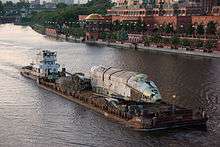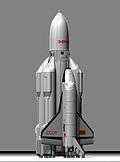2.01 (Buran-class spacecraft)
| 2.01 | |
|---|---|
_Baikal_(8605746284).jpg) | |
| Country | Soviet Union |
| Status | unfinished |
| Time spent in space | Never flew in space |
2.01 is the designation of the third space shuttle to be produced as part of the Soviet/Russian Buran program. It carried the GRAU index serial number 11F35 K3 and is - depending on the source - also known as "OK-2K1", "Orbiter K3", "OK 2.01" or "Shuttle 2.01". Its construction was not complete when the Buran program was ended (30-50 percent done), so it remains unfinished.[1]
Differences from OK-1K1
The 2.01 is the first of a second series of Buran-class shuttle orbiters. The main differences between the second series and the first operational Soviet shuttles are located in the cockpit, which has been improved using feedback from the earlier models of Buran-class shuttles, such as the flight of OK-1K1 and the construction of OK-1K2.[1]
Projected flights
It was projected in 1989 that orbiter 2.01 would have its first manned space test flight in 1994, with a duration of twenty-four hours. The craft would have been equipped with a life support system and two ejection seats. Crew would have consisted of two cosmonauts — Igor Volk (commander) and Aleksandr Ivanchenko (flight engineer).[2]
Post-retirement

After residing at the Tushino factory where it was constructed, it was incorrectly announced in 2006 that orbiter 2.01 would be put on display in the Sinsheim Auto & Technik Museum, Germany. However, the German Museum had actually bought OK-GLI, the jet-powered Buran atmospheric test vehicle, which will be on display in its own new hangar from September 2008.[1]
Since 2004 the orbiter 2.01 had been left under open sky on a car park in Moscow, near Khimki Reservoir.[3] [4] [5] [6][7]
On 22 June 2011 during the day the orbiter was put on a barge[8] to be moved to the MAKS 2011 international air show, which took place from 16 to 21 August in Zhukovsky (Moscow region).[9] In the night of 22–23 June it was seen on the Moskva River.[10][11] As of November 2013, it remained at the Ramenskoye–Zhukovsky Airport (55°33′06″N 38°08′40″E / 55.5517°N 38.1444°E).[12]
As of July 2017, heat-tiles from orbiter 2.01 are for sale online, indicating that it may have been scrapped or otherwise disassembled.[13]
References
- 1 2 3 "Shuttle Buran 2.01 current status". Retrieved 2006-08-05.
- ↑ Экипажи "Бурана" Несбывшиеся планы. (in Russian). buran.ru. Retrieved 2006-08-05.
- ↑ "Where Do Shuttles Go?". English Russia. 2008-07-30. Retrieved 2011-08-20.
- ↑ Moscow (1970-01-01). "moscow - Google Maps". Maps.google.com. Retrieved 2011-08-20.
- ↑ "Тушинский машиностроительный завод, на котором строился космический челнок "Буран", открестился от своего детища". 5-tv.ru. 2010-09-30. Retrieved 2011-08-20.
- ↑ Автор: Дмитрий Мельников (2010-09-28). "Вести.Ru: "Буран" остался без крыльев и хвоста". Vesti.ru. Retrieved 2011-08-20.
- ↑ "Archived copy". Archived from the original on 2014-03-16. Retrieved 2013-09-13.
- ↑ http://www.buran-energia.com/blog/wp-content/uploads/2011/06/5859100207_bacdfeb4f3.jpg
- ↑ "Buran-Energia Buran OK-2.01". Buran-energia.com. Retrieved 2011-08-20.
- ↑ https://www.tagesschau.de/multimedia/bilder/buran102_v-grossgalerie16x9.jpg
- ↑ "7289 – Проект 942 — Водный транспорт". Fleetphoto.ru. Retrieved 2011-08-20.
- ↑ Russian Space Agency VKK Buran 2.01: Photo dated 27 November 2013.
- ↑ "Buran Space Shuttle Shop - Buran's tile". www.buran-energia.com.
See also
- Mikoyan-Gurevich MiG-105 — Soviet orbital spaceplane
- Spaceplane
- Spacecraft
External links
| Wikimedia Commons has media related to Buran (spacecraft). |

